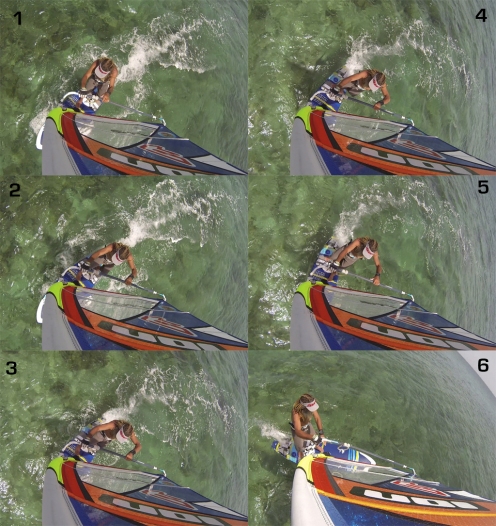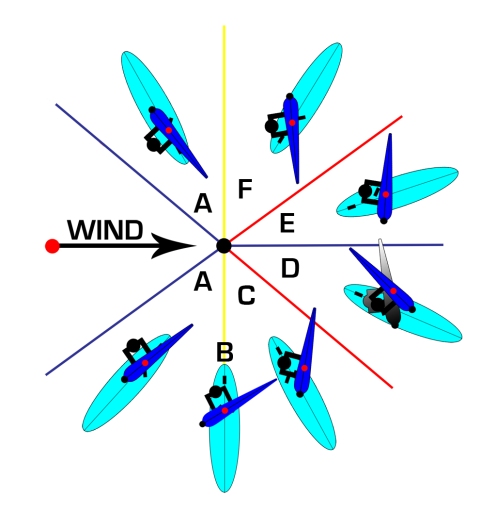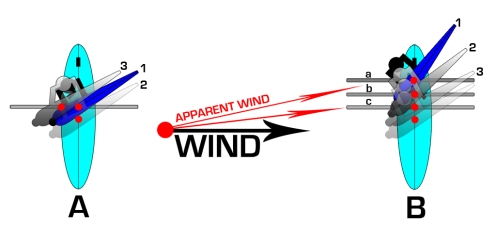GYBE / JIBE.
What is it?
A gybe is turning around passing the sail over the front of the board. Sailing away from the wind, turning the back of the board through the wind, the sail has power all of the time.
There are so many types of gybe, depending on speed, wind strength or just how you feel and want to play around a bit to give it some style.
So where is the gybe?
When you are sailing, especially a short board you are always going upwind. So the sailing sector is A.)
When you want to gybe, go to B.) to get the board up to speed and be in a position where you can set up for the gybe.
Sector C.) is where you find the speed and drive for the gybe.
D.) and E.) are the sectors of the gybe. E.) is where you change your feet and sail.
F.) is the sector where you sail up to the new cause you want to sail.
You will notice the gybe is a very small section of the turn when you are sailing upwind.
In all gybes the rig is always steering you.
A.1) the Centre of effort of the sail is over the central lateral resistance of the board, the board goes straight.
A.2) it is forwards, the board turns down wind.
A.3) it is to the side, again this position will turn the board down wind.
The CE (centre of effort of the sail keeps relatively constant) but the CLR (central lateral resistance) is constantly changing with the speed of the board or the amount of board in the water.
Looking at B.) you will see this makes a lot of difference in a gybe, depending whether you are accelerating or slowing down. B.a.1) is high speed, B.b.2) is medium speed and B.c.3) is slow speed.
The aim with gybing is to always be accelerating, especially into the gybe, so you can see this makes things much easier. The problem comes when you slow down. If you stay in B.a.1) and slow down, the board will turn upwind.
You come onto a reach as in 1.a) with full power in the sail. There are several options for the next stage depending on how much speed you have. With enough speed you will be carving so the rig position is 1.b) You have eased the power so you can come over the centre of the board to command the board with your back foot.You also notice the CE has moved over the side so the rig is still turning you down wind. 1.c) you are just using the mast forward with power to turn the board.
As the board goes away from the wind the board will accelerate, so your apparent wind moves forwards. It is important to close the sail. So 2.c) is light wind with very little acceleration, 2.a) is powering the board round with a little bit of foot steering and 2.b) is starting to commit to full carving.
3.a) is a carve gybe and 3.b) is more a power gybe where you do not get the acceleration and have to use the rig more.
In 4.) I have shown the apparent wind moving very forwards which happens especially when you are using big sails in medium winds. You accelerate so much, going up to 2 times faster than the wind. Meaning you have to close the sail as in a.) having full commitment into the turn. 4.b) the wind stays as in 3.) and 4.c) as in 2.)
Now we go into the gybe sector. Many things can happen depending on the speed of the board.
Rig a.) is a light wind gybe or you slow right down, Rig.b) is high speed.
Looking at 1./2./3, rig a.) is not changing in relation to the board, the CE is staying over the rail of the board.
Rig b.) in 1./ 2. also stays in the same relation to the board, front arm extended and the mast down the centre of the board. When you keep the rig in the same relation to the wind it will be as in c.)
The rig change can start to happen in 3.) but most of the time you will come round to 4.) and be clew first for stability before you change.
You can take a look at an earlier article here:- https://thewavehobbit.wordpress.com/windsurfing/analysis-corner/the-power-to-carve/
I discussed the command of the board in my wave article, so here it is again to remind you.
“The back foot is your command foot and the front, your drive.
When wave riding we have our back foot in the strap which means we can give more command and body angulation than in a gybe.
Command………….. The corner of the board by the back foot strap needs to go into the water to cut a groove. The faster the turn, the deeper the groove needs to be. Placing pressure on the back foot will make the nose go up. If you look at C.1. you will see that the back leg is bent and the knee is over the rail of the board.
If you keep your body upright and only put pressure through your toes or you create the angle by lifting your front foot, the command will be weak and the board will not dig that groove. You will see in C. that the body stays perpendicular to the board. The more angle, the more the body will lean.
You need drive, this comes from the sail. It is easier to start the command from neutral as in B.1. The sail pulls you forwards, creating drive through your front foot B.2/3/4, bringing the nose down. It is important to keep the board angle. A common mistake is your body goes out against the pull of the sail as in C.3.b, releasing the pressure on the rail. This flattens out the curve creating more pressure in the sail, you can not hold it so you open the sail, reducing the drive.
Another common thing that happens, C.4 you try to let the rig pull you forwards to create the drive but you have not given enough command so the board is not cutting a groove.
In C.5 you can see that the radical lay down bottom turn is not you laying down the sail but just created by the amount of lean. For this angle the groove has to be deep and still half of the board will be out of the water.”
As stated, the only difference is that your back foot is out of the strap but should be as near to the back strap as possible.
The hardest part of the gybe is the rig control coming out of the gybe and the foot change. So lets have a look at various gybes to see what happens.
When changing your feet it is important to think about keeping the board balanced. So you must think about where the centre of balance is on the board, remember it changes depending on how fast you are going. For you to keep balanced, stay low.
Here are 2 slightly different rig changes.
In 2.A.) the back hand is not so far back so it is easier to move the front hand before the change, where as in B.) there can be a split second where you have no hands on the boom.
3.A) is using the mast which helps you keep low, B.) is boom to boom.
I always say a good gybe is a gybe where you do not fall in.
So remember your neutral positions.









